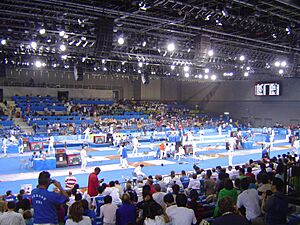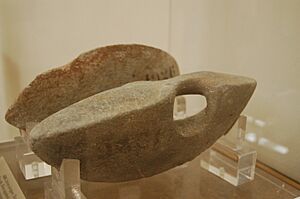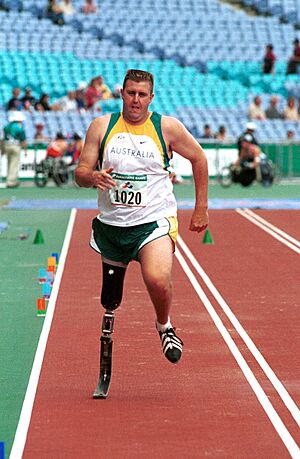Pentathlon facts for kids
A pentathlon is a sports contest with five different events. The name comes from Greek words: pente (meaning five) and -athlon (meaning competition). The very first pentathlon was recorded in Ancient Greece and was part of the Ancient Olympic Games.
In the Ancient Olympics, five events were held on one day. These included the long jump, javelin throwing, and discus throwing. After these, athletes competed in the stadion (a short running race) and wrestling. Pentathletes were seen as very skilled athletes. Their training was often part of military service because each event was thought to be useful in war.
When the Olympic Games returned in modern times, the pentathlon came back in two forms. The athletics pentathlon was like the original Greek events, but with five different track and field competitions. The modern pentathlon was created by Pierre de Coubertin, who started the Modern Olympics. This version was based on the skills a soldier needed in the late 1800s. It included shooting, swimming, fencing, equestrianism (horse riding), and cross country running. In modern pentathlons, athletes earn points for how well they do in each event. The person with the most points at the end wins!
History of the Pentathlon
Ancient Olympic Games
The first time a pentathlon was officially recorded was in 708 BC. This happened in Ancient Greece at the Ancient Olympic Games. It was also held at other big Greek sports events called the Panhellenic Games. The name means "five competitions" in Greek.
This event became very popular and was often shown on ancient Greek pottery. It even appeared in Greek mythology. For example, the hero Perseus accidentally killed a king with a discus while competing in the pentathlon. Another myth says that Jason invented the pentathlon. He declared his friend Peleus the first winner after Peleus won the wrestling part.
Because pentathletes needed many different skills, they were highly respected for their physical abilities. The famous Greek thinker Aristotle once said that pentathletes had "a body capable of enduring all efforts." This meant they were strong and fit for many challenges.
By the 77th Olympics, the events were usually in a set order. First came the triagmos (the long jump, javelin throw, and discus throw). Then, athletes ran the stadion foot race. Finally, they finished with wrestling. Unlike today's athletics, the first three events were usually only part of the pentathlon, not separate competitions. Sometimes, boxing or pankration (a mix of boxing and wrestling) took the place of the stadion race.
Modern Olympic Games
The pentathlon returned to the Olympics at the 1906 Games in Athens. This version included a standing long jump, an ancient style discus throw, javelin throw, a 192-meter run, and a Greco-Roman wrestling match.
At the 1912 Summer Olympics, two new types of pentathlon were introduced. The first was the classic pentathlon. This was an athletics competition similar to the ancient one. It included the long jump, javelin throw, 200 metres race, discus throw, and a 1500 metres race. This event was also held in the 1920 and 1924 Summer Olympics but was then stopped.
The second type of pentathlon introduced in 1912 was the modern pentathlon. This sport was invented by Pierre de Coubertin. He wanted to create a competition that tested the skills a soldier needed, just like in ancient times. The idea was to imagine a 19th-century soldier fighting behind enemy lines. This contest includes épée fencing, pistol shooting, freestyle swimming, show jumping on a horse the athlete has never ridden before, and a cross country run. Athletes earn points for their performance in each event. The person with the highest total points at the end wins. The men's individual competition has been in every Olympic Games since 1912. A women's competition was added in the 2000 Summer Olympics.
A women's athletics pentathlon event was added at the 1964 Summer Olympics in Tokyo. It featured the 80 metres hurdles, shot put, and high jump on the first day. On the second day, there was the long jump and a 200-meter race. For the 1976 and 1980 Summer Olympics, the hurdles race changed from 80 to 100 metres hurdles, and the 200-meter race changed to an 800 metres race. This event was stopped in 1984 and replaced by the heptathlon, which has seven events.
Types of Pentathlon
Ancient Pentathlon
| Events |
|---|
| Long jump |
| Javelin throw |
| Greek style discus throw |
| Stadion |
| Wrestling |
The way the Ancient Olympic pentathlon was scheduled and what events were included sometimes changed. For example, the stadion running event was sometimes replaced by boxing or pankration.
The discus throw was done in the Greek style. Athletes would throw the discus from a raised platform. For the long jump, athletes used halteres. These were stone weights that athletes held and swung to help them jump further. The stadion race was usually about 190 meters long, which was the length of the Stadium at Olympia.
Modern Pentathlon
| Events |
|---|
| Shooting |
| Swimming |
| Fencing |
| Equestrian |
| Cross country running |

The International Modern Pentathlon Union (UIPM) is the group that manages this sport. Besides the Olympics, there are world championships held in years when there are no Olympic Games.
For most of its history, the modern pentathlon stayed pretty much the same as it was in the 1912 Olympics. However, at the 2000 Summer Olympics, the 300-meter freestyle swimming race was shortened to 200 meters. Also, the 4000-meter cross country race was reduced to 3000 meters.
The fencing (épée) event is the only one where competitors directly face each other. Each athlete must fence every other opponent once. An épée duel lasts up to one minute. The first person to land a hit wins. If no one hits within a minute, the match is a draw.
The riding event involves show jumping over a course that is 350 to 450 meters long with 12 to 15 obstacles. Competitors are given a horse by drawing lots just 20 minutes before the event starts. The shooting event uses a 4.5 mm air pistol. Athletes stand 10 meters away and shoot at a still target.
In 2009, the UIPM suggested combining the running and shooting events into one, similar to the biathlon. Some people thought the sport should be called a "tetrathlon" (meaning four events) because of this change. However, the sport's leaders say that five different skills are still used in the competition.
The 'combined' event is the last part of the pentathlon. It's a continuous race that mixes shooting and running. Athletes start based on their total points from the first three events. This makes it a chase race to see who finishes first overall. Since 2012, the combined event has a 4x800 meter running loop. At the start of each loop, athletes must shoot a 10-meter air pistol. They have to hit the target 5 times before they can continue running the next loop. In 2011, the UIPM started using laser shooting instead of traditional pellets for this combined event.
Athletics Pentathlons
Since there are many different track and field events, there have been several types of pentathlons with various combinations of events.
Classic Pentathlon
| Events |
|---|
| Long jump |
| Javelin throw |
| 200 metres |
| Discus throw |
| 1500 metres |
The Classic pentathlon was part of the Olympic Games from 1906 to 1924. At the 1912 Olympic Games, Jim Thorpe won both the pentathlon and decathlon titles. However, his titles were later taken away because he had played professional sports. His titles were given back to him about 70 years later by the International Olympic Committee.
In the United States, this type of pentathlon was a championship event for the Amateur Athletic Union (AAU) until 1978. After the AAU changed, track and field sports came under new leadership. The Athletics Congress (TAC), now called USA Track & Field, decided to stop holding the pentathlon as a national championship event for adults. However, it is still recognized as a national championship event for younger age groups (11–12 and 13–14 years old). The last National AAU Pentathlon Championships was held in Honolulu, Hawaii, in 1978.
Pentathlons are also used in high school athletics and at other one-day sports events to save time. The events are separated by age and gender, but the five events are the same for both: sprint hurdles, long jump, shot put, high jump, and a middle distance run. For athletes under 12 (U12), the sprint hurdles are 80 meters long (with 30-inch hurdles). The shot put weighs six pounds. The middle-distance run is 1500 metres for boys and 800 metres for girls. For athletes under 14 (U14), the sprint hurdles are 100 meters long (with 33-inch hurdles for boys and 30-inch for girls). The shot put for boys is 4 kg (about three pounds heavier).
Indoor Pentathlon
| Events |
|---|
| 60 metres hurdles |
| High jump |
| Shot put |
| Long jump |
| 800 metres |
In the indoor pentathlon, points are given based on how well an athlete performs in each event. These points can be figured out using a standard system. The indoor pentathlon takes place over one day. All athletes complete one event at the same time, then there is a 30-minute break before the next event.
Currently, Nafissatou Thiam holds the world record for the indoor pentathlon with 5055 points. She set this record on March 3, 2023, in Istanbul, Turkey.
The International Association of Athletics Federations (IAAF), which is the main group for athletics worldwide, holds a women's pentathlon contest at the World Indoor Championships in Athletics. Athletes who compete in this event are usually heptathlon specialists, as the events are very similar to that seven-event competition. Until 2000, men also competed in the indoor pentathlon.
The men's pentathlon was added to the IAAF list of indoor world records in 1990, at the same time as the men's heptathlon.
Paralympic Pentathlon
| Events | ||
|---|---|---|
| Vis. imp. | Amputee | Spinal |
| Long jump | Shot put | |
| Javelin throw | Shot put | Javelin throw |
| 100 metres | 200 metres | |
| Discus throw | ||
| 1500 metres | 400 metres | 1500 metres |
The events in the Summer Paralympics pentathlon changed depending on whether the athletes had visual impairments, amputations, or spinal conditions. The events listed in the table on the right are from the 2004 Summer Paralympics. No pentathlon events were held in the 2012 Summer Paralympics.
Military Events
| Military pentathlon | Naval pentathlon | Aeronautical pentathlon |
|---|---|---|
| Shooting | Obstacle race | Shooting |
| Obstacle running | Life saving swimming race | Fencing |
| Obstacle swimming | Utility swimming race | Orienteering |
| Throwing | Seamanship race | Basketball skills |
| Cross country running | Amphibious cross-country race | Obstacle course |
| Swimming |
By the mid-1900s, some skills in the modern pentathlon, like fencing and horse riding, were becoming less important for modern soldiers. A French army officer named Captain Henri Debrus changed a military training method into a five-event competition. The five events are: shooting, obstacle running, obstacle swimming, throwing, and cross country running.
The International Military Sports Council (CISM) manages this sport. An annual world championship has been held since 1950.
Aeronautical Pentathlon
Aeronautical pentathlon is a sports event at some multi-sport competitions, such as the Military World Games. Even though it's called a pentathlon, it actually has six events: shooting, fencing, orienteering, basketball skills, obstacle course, and swimming. The goal is to help train athletes for escaping enemy soldiers. It is usually only for military Air Forces. It first appeared at the Military World Games in 2010.
See also
 In Spanish: Pentatlón para niños
In Spanish: Pentatlón para niños





